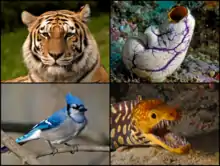Olfactores
Olfactores is a clade within the Chordata that comprises the Vetulicolia, Tunicata (Urochordata) and the Vertebrata (sometimes referred to as Craniata). Olfactores represent the overwhelming majority of the phylum Chordata, as the Cephalochordata are the only chordates not included in the clade.
| Olfactores | |
|---|---|
 | |
| Example of Olfactores | |
| Scientific classification | |
| Kingdom: | Animalia |
| Subkingdom: | Eumetazoa |
| Clade: | ParaHoxozoa |
| Clade: | Bilateria |
| Clade: | Nephrozoa |
| Superphylum: | Deuterostomia |
| Phylum: | Chordata |
| Clade: | Olfactores |
| Subgroups | |
Olfactores hypothesis
For long, the hypothesis that cephalochordata is sister taxon to craniata seemed to be widely accepted,[1] likely influenced by the morphological distinction of tunicata from other chordates, with cephalochordates even being nicknamed ‘honorary vertebrates’.[2] However, since 2006, studies based on the analysis of large sequence datasets strongly supported the Olfactores as a clade.[3][4] The name olfactores comes from Latin olfactus ("sense of smell"), due to the pharynx development as to include respiratory functions, in contrast to the lack of respiratory system and specialized sense organs seen in cephalochordates such as the lancelet.[5]
References
- Stach, Thomas (2008). "Chordate phylogeny and evolution: a not so simple three‐taxon problem". Journal of Zoology. 276 (2).
- Ax, P (2001). "Das System der Metazoa: ein Lehrbuch der phylogenetischen Systematik". Cite journal requires
|journal=(help) - Delsuc, F (2006). "Tunicates and not cephalochordates are the closest living relatives of vertebrates" (PDF). Nature. 439 (7079): 965–968. Bibcode:2006Natur.439..965D. doi:10.1038/nature04336. PMID 16495997.
- Dunn, C.W. (2008). "Broad phylogenetic sampling improves resolution of the animal tree of life". Nature. 452: 745–749. doi:10.1038/nature06614.
- Benton, M.J. (14 April 2000). Vertebrate Palaeontology: Biology and Evolution. Blackwell Publishing.